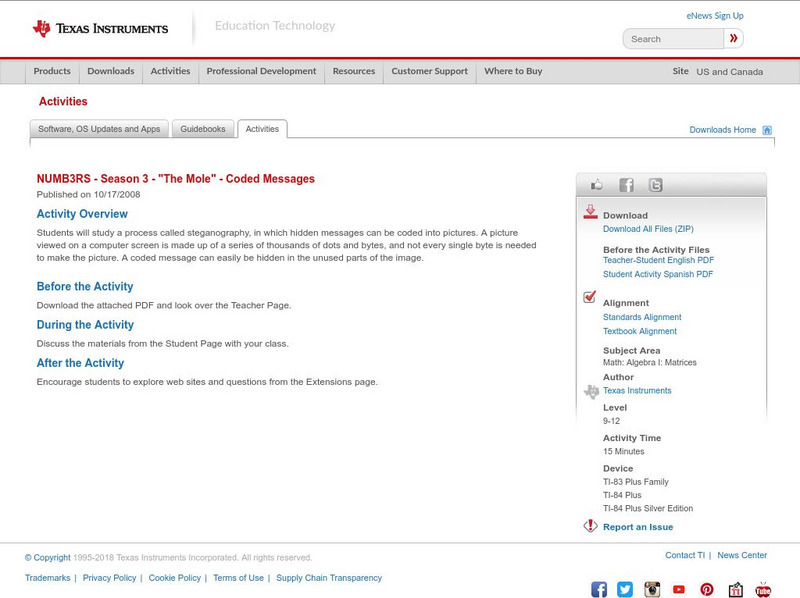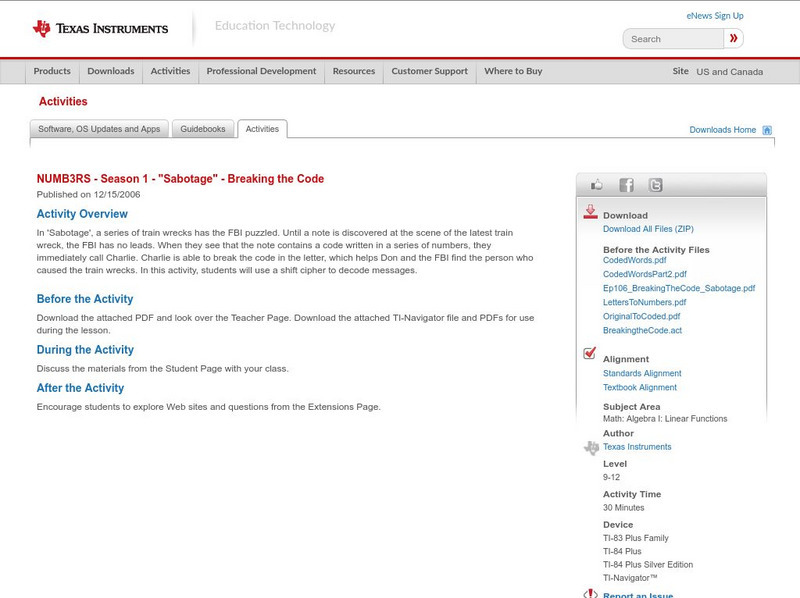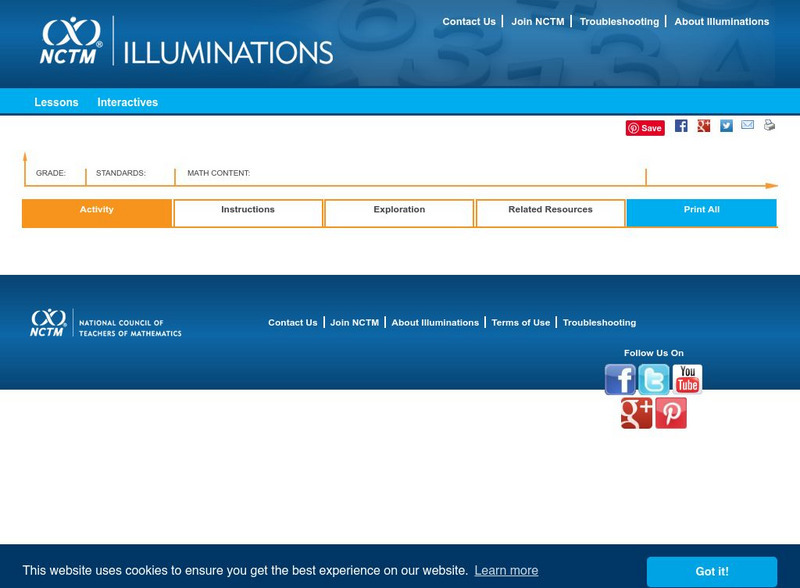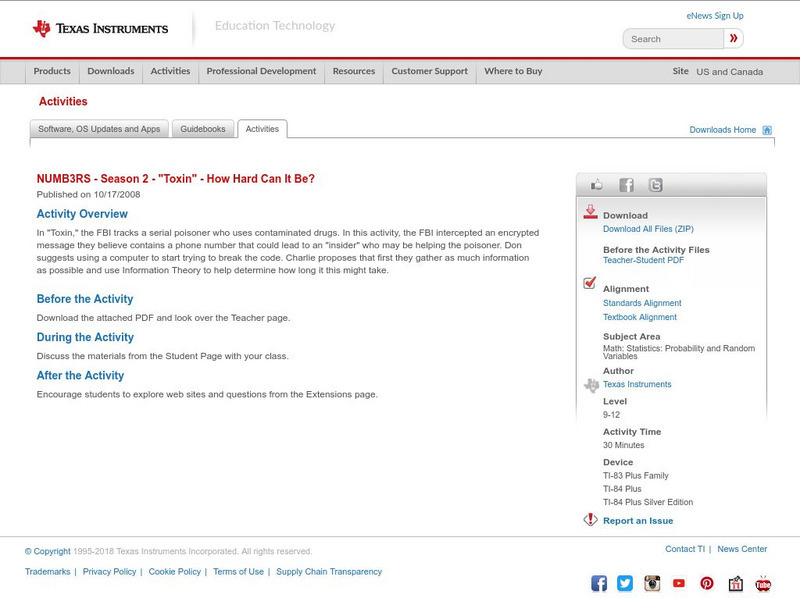Hi, what do you want to do?
Curated OER
Cryptography on the TI-83 Graphing Calculator
Students explore the history of cryptography. They assess function notation and transformation, matrix operations, and the fundamentals of modular arithmetic. Using graphing calculators, students develop their own encryption schemes.
Curated OER
Secret Sharing with Linear Equations
High schoolers use linear equations to reveal a secret message. They practice writing linear equations from two ordered pairs. Students determine the y-intercept of the line from the equation. They reveal the secret message from the...
Curated OER
DNA Chips
Young scholars discover what they need to know about DNA chips. They extend this knowledge to analyze gene expression data to diagnose two kinds of leukemia.
Curated OER
DNA Chips
Students explore issues surrounding DNA microarray technology. They focus on a single area of biomedical research to help them explain how science, people, ethics, and history all fit together. They analyze gene-expression data.
Curated OER
DNA Extraction
Students are able to extract and observe a visible amount of DNA from Escherichia coli cells. They discuss the properties of DNA. Students confirm the presence of DNA by a reaction with an indicator.
Curated OER
Clock Arithmetic and Cryptography
Students explore the concept of modular arithmetic and cryptography. For this modular arithmetic and cryptography lesson, students use applets to explore modular arithmetic using a clock and Caesar Ciphers. Students exchange their...
Curated OER
DNA Profile Analysis
Students obtain a DNA sample, observe DNA Using Agarose Gel Electrophoresis, and obtain reagents and equipment.
Curated OER
Color Enhanced Maps
Students download or create maps with numerical weather data. They add isolines and color to create regions on their maps. They explore the visual properties of color palettes and create a visualization applying their knowledge.
Curated OER
Protein Synthesis and Words
Students explain the roles of mRNA, tRNA and ribosomes. They explain how mutations can occur in an individual. Students simulate parts of a cell to access about the process of protein synthesis.
Curated OER
Cryptography Implementation
Students explore cryptology. They write a research paper on cryptography. Using linear equations, students invent a code and write a secret message. Students complete cryptography puzzles.
Curated OER
Pixel Transmission
High schoolers develop code systems to transmit information between groups. They explore, explain and apply techniques used to transmit remote sensing data to better understand remote sensing images.
Curated OER
Whose DNA Is That?
Students investigate the use of technology in order to identify different sequences of amino acids by using online web tools. They enhance problem solving skills with amino acid identification skills and strengthening comfort with using...
Curated OER
Science: Designer genes
Students engineer new organisms using biotechnology. In small groups, they write procedures, list benefits and drawbacks, and explain how their new organism might affect the environment. After creating their new organisms, they present...
Curated OER
Basic Crypto Systems
Learners try to solve codes mathematically. The use of a code needs a key. Students try to decipher a code with a mathematical key. This requires focus and higher order thinking skills like analysis.
Curated OER
Biology Honors Final Project
Tenth graders work on a project about cellular biology and genetics. In this biology lesson plan, 10th graders research about the assigned human body system and genetic disorders that affect it. They create a multimedia presentation and...
TeachEngineering
Teach Engineering: Rotary Encoders & Human Computer Interaction
Students learn about rotary encoders and discover how they operate through hands-on experimentation. Rotary encoders are applied in tools to determine angle measurements and for translations of angular motion. One common rotary encoder...
TeachEngineering
Teach Engineering: Ding! Going Up? Elevators and Engineering
Students create model elevator carriages and calibrate them, similar to the work of design and quality control engineers. Students use measurements from rotary encoders to recreate the task of calibrating elevators for a high-rise...
TeachEngineering
Teach Engineering: Smart Move!
This is a simple activity to visualize a communication system. In order to do this the students encode, decode, transmit, receive, and store messages. They will use a code sheet and flashlight for this process. They will also maintain a...
Shodor Education Foundation
Shodor Interactivate: Caesar Cipher
Create your own affine cipher for encoding and decoding messages. Input your own constant and multiplier, then input a message to encode.
Texas Instruments
Texas Instruments: Numb3 Rs: Coded Messages
Based off of the hit television show NUMB3RS, this lesson uses matrices (inverse and multiplication) to decode messages hidden within digital pictures -- a process known as steganography. This method of hidden communication is known to...
Texas Instruments
Texas Instruments: Numb3 Rs: Breaking the Code
Based off of the hit television show NUMB3RS, this lesson introduced students to simple coding techniques (namely, the shift cipher). Students learn to translate codes from nonsense to English by quantifying each letter, and then...
Other
National Engineers Week Foundation: Hearing the Light
Students learn how laser communication systems are built by observing how sound can be encoded into, and transmitted by a light beam.
National Council of Teachers of Mathematics
Nctm: Illuminations: Codes
This is a computer based program that allows students to understand basic cryptography which utilizes transformations of shifting and stretching. Students may encode their own message and see it graphically.
Texas Instruments
Texas Instruments: Numb3 Rs: How Hard Can It Be?
Based off of the hit television show NUMB3RS, this lesson introduces students to one way of defining the strength of an encryption (called "Entropy"). In the lesson, students learn how to calculate the entropy of a given code, and then...




























